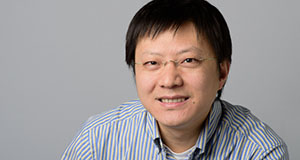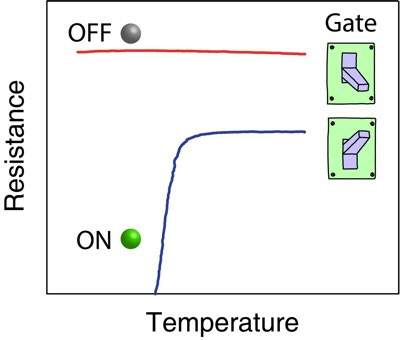First superconducting transistor at practical voltage and temperature
A team of physicist from the University of Groningen lead by professor Justin Ye has constructed a superconducting transistor that operates at a few Kelvin. The back gate, which switches the molybdenum disulfide transistor from the metallic to the superconducting phase operates continuously at low voltage. A transistor like this could be used in quantum logic circuits. The results were published on May 28th, 2018 in the journal Advanced Materials.

Switching the properties of quantum electronic systems, like the superconducting phase, is quite challenging. Superconducting transistor-like devices have been constructed, but these prototypes still have major drawbacks, explains University of Groningen associate professor of Quantum Interfaces and Device Physics Justin Ye. ‘Most of these systems can perform continuous switching, as they need to be cooled down or warmed up to do this. Furthermore, for exceptions that can be tuned contnously, a high voltage is needed to switch between states, as well as temperatures below 1.5 Kelvin.’ Cooling below this temperature requires complex equipment and the very rare Helium-3.
By contrast, Ye now presents a dual gate device in which he can switch between metallic and superconducting phase with a low voltage back gate for 20 Volts at ~10 Kelvin. The device, based on molybdenum disulfide, operates like a field effect transistor. Ye uses an ionic liquid gate to add charge carriers to the material. This is tuned to the tipping point between the metallic and superconducting phase, so a back gate of hafnium oxide operating below 20 volt can switch the device between states.

‘As far as I know, we are the first to make a superconducting transistor with continuous switching at temperatures at a easily accessible temperature of a few Kelvin’, says Ye. The latter means that his transistor operates in a relatively simple cooling device using Helium-4. Ye’s group first showed that molybdenum disulfide – a semiconductor, but also a common dry lubricant – became a superconductor at low temperatures in 2012. ‘We used the same type of device in this new experiment, but we improved the dielectric properties of the back gate, to obtain a bigger range of tuning carriers.’
This process took several years, but the result is quite rewarding. ‘We can now switch a quantum state. Eventually, this could lead to the construction of superconducting logic circuits.’ But although the current device shows all the function of a real transistor, such an application is still a long way off. ‘The next step is to show the frequency response’, says Ye. However, building applications is one of the aims of his group. ‘We are into scientific exploration; we make devices with the aim to find both new physical phenomena and new functionaliites.’
Reference
Continuous Low‐Bias Switching of Superconductivity in a MoS2Transistor Qihong Chen, Jianming Lu, Lei Liang, Oleksandr Zheliuk, Abdurrahman Ali El Yumin & Jianting Ye, Advanced Materials, Early Online Version (28 May 2018)
DOI: https://doi.org/10.1002/adma.201800399
For more information please contact Prof. Justin Ye
| Last modified: | 29 May 2018 12.36 p.m. |
More news
-
24 March 2025
UG 28th in World's Most International Universities 2025 rankings
The University of Groningen has been ranked 28th in the World's Most International Universities 2025 by Times Higher Education. With this, the UG leaves behind institutions such as MIT and Harvard. The 28th place marks an increase of five places: in...
-
05 March 2025
Women in Science
The UG celebrates International Women’s Day with a special photo series: Women in Science.
-
16 December 2024
Jouke de Vries: ‘The University will have to be flexible’
2024 was a festive year for the University of Groningen. In this podcast, Jouke de Vries, the chair of the Executive Board, looks back.
